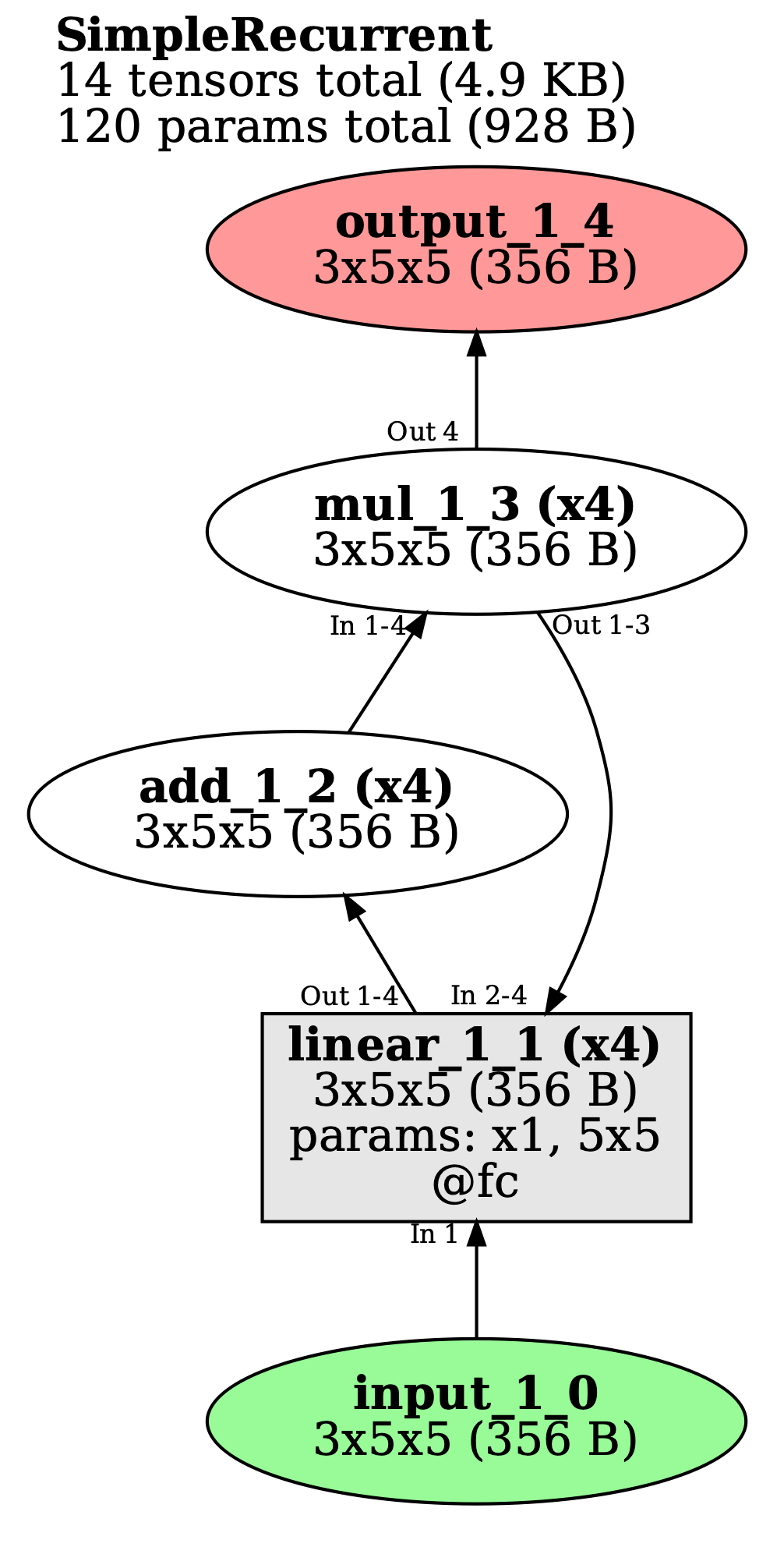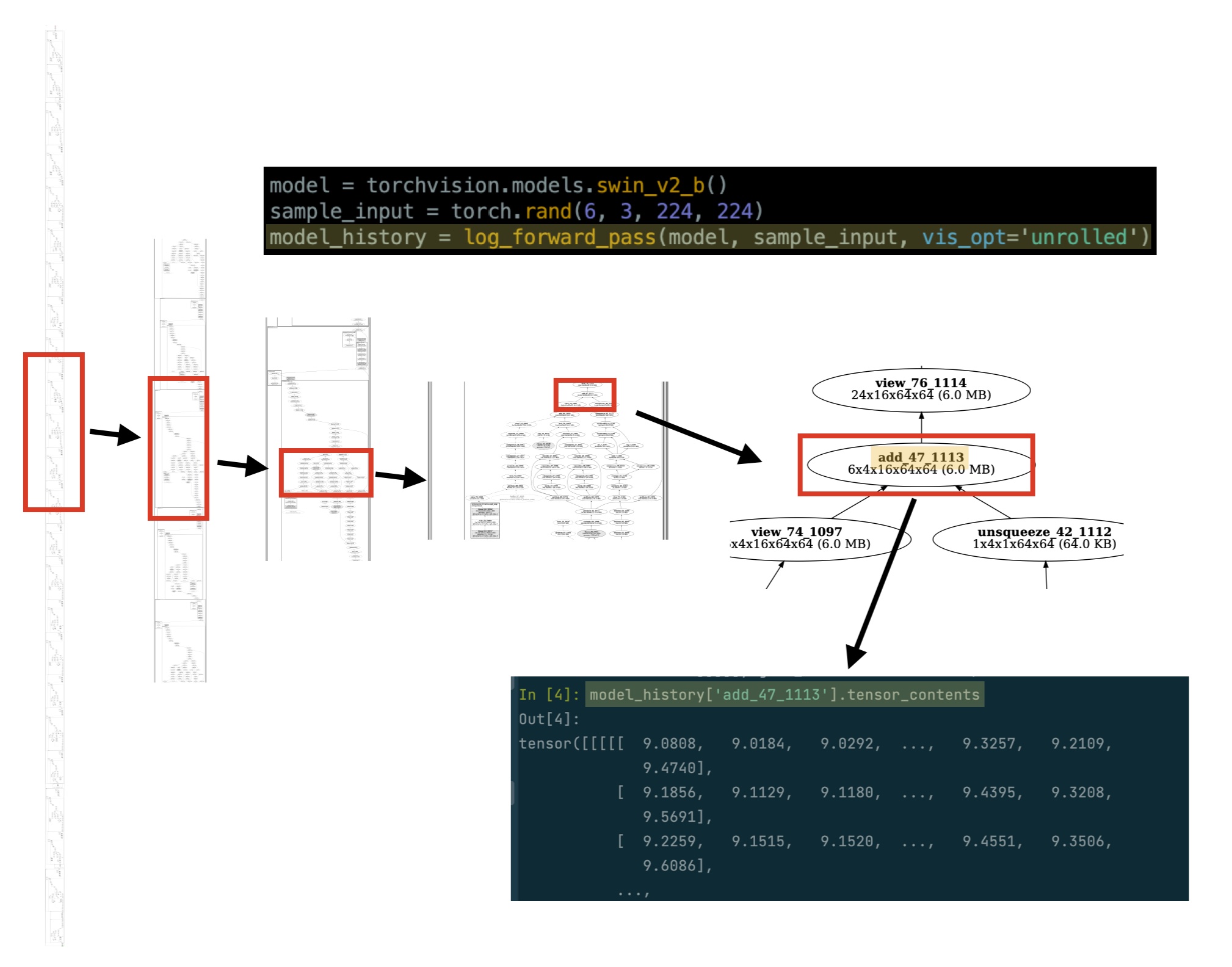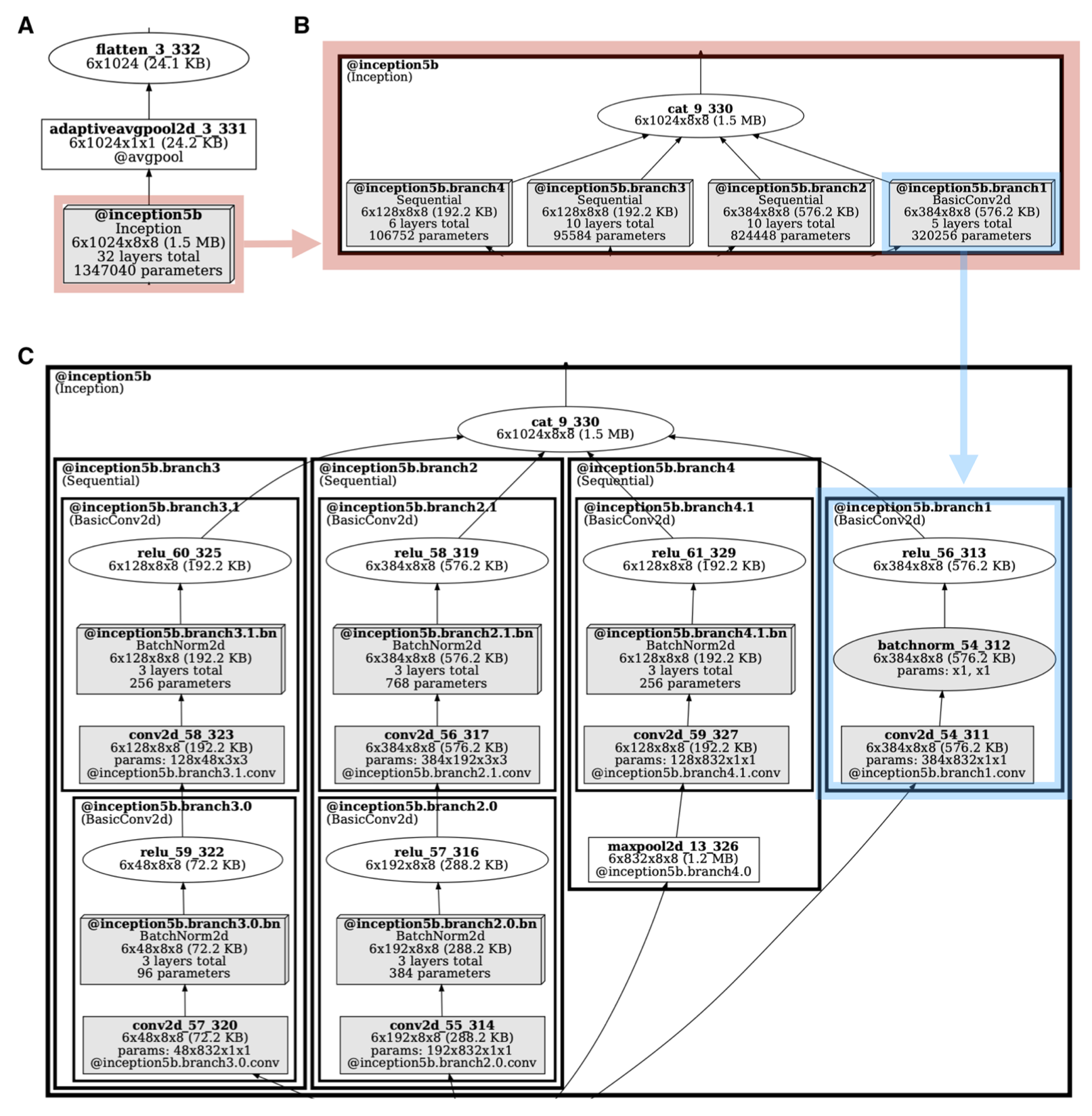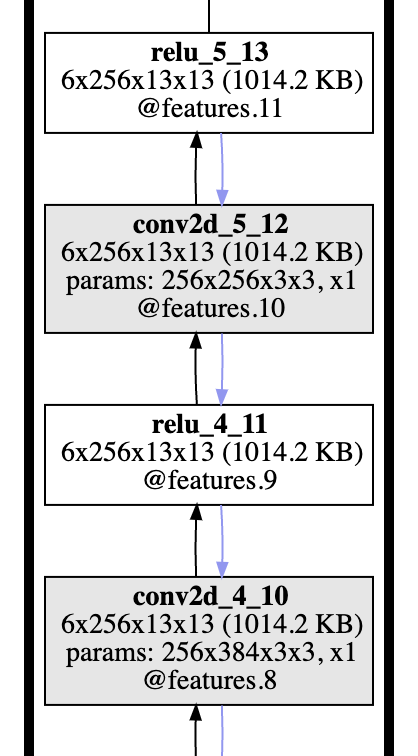Quick Links
- Paper introducing TorchLens
- CoLab tutorial
- "Menagerie" of model visualizations
- Metadata provided by TorchLens
TorchLens is a package for doing exactly two things:
- Easily extracting the activations from every single intermediate operation in a PyTorch model—no modifications needed—in one line of code. "Every operation" means every operation; "one line" means one line.
- Understanding the model's computational structure via an intuitive automatic visualization and extensive metadata (partial list here) about the network's computational graph.
Here it is in action for a very simple recurrent model; as you can see, you just define the model like normal and pass it in, and TorchLens returns a full log of the forward pass along with a visualization:
class SimpleRecurrent(nn.Module):
def __init__(self):
super().__init__()
self.fc = nn.Linear(in_features=5, out_features=5)
def forward(self, x):
for r in range(4):
x = self.fc(x)
x = x + 1
x = x * 2
return x
simple_recurrent = SimpleRecurrent()
model_history = tl.log_forward_pass(simple_recurrent, x,
layers_to_save='all',
vis_opt='rolled')
print(model_history['linear_1_1:2'].tensor_contents) # second pass of first linear layer
'''
tensor([[-0.0690, -1.3957, -0.3231, -0.1980, 0.7197],
[-0.1083, -1.5051, -0.2570, -0.2024, 0.8248],
[ 0.1031, -1.4315, -0.5999, -0.4017, 0.7580],
[-0.0396, -1.3813, -0.3523, -0.2008, 0.6654],
[ 0.0980, -1.4073, -0.5934, -0.3866, 0.7371],
[-0.1106, -1.2909, -0.3393, -0.2439, 0.7345]])
'''And here it is for a very complex transformer model (swin_v2_b) with 1932 operations in its forward pass; you can grab the saved outputs of every last one:
The goal of TorchLens is to do this for any PyTorch model whatsoever. You can see a bunch of example model visualizations in this model menagerie.
To install TorchLens, first install graphviz if you haven't already (required to generate the network visualizations), and then install TorchLens using pip:
sudo apt install graphviz
pip install torchlensTorchLens is compatible with versions 1.8.0+ of PyTorch.
Below is a quick demo of how to use it; for an interactive demonstration, see the CoLab walkthrough.
The main function of TorchLens is log_forward_pass: when called on a model and input, it runs a
forward pass on the model and returns a ModelHistory object containing the intermediate layer activations and
accompanying metadata, along with a visual representation of every operation that occurred during the forward pass:
import torch
import torchvision
import torchlens as tl
alexnet = torchvision.models.alexnet()
x = torch.rand(1, 3, 224, 224)
model_history = tl.log_forward_pass(alexnet, x, layers_to_save='all', vis_opt='unrolled')
print(model_history)
'''
Log of AlexNet forward pass:
Model structure: purely feedforward, without branching; 23 total modules.
24 tensors (4.8 MB) computed in forward pass; 24 tensors (4.8 MB) saved.
16 parameter operations (61100840 params total; 248.7 MB).
Random seed: 3210097511
Time elapsed: 0.288s
Module Hierarchy:
features:
features.0, features.1, features.2, features.3, features.4, features.5, features.6, features.7,
features.8, features.9, features.10, features.11, features.12
avgpool
classifier:
classifier.0, classifier.1, classifier.2, classifier.3, classifier.4, classifier.5, classifier.6
Layers:
0: input_1_0
1: conv2d_1_1
2: relu_1_2
3: maxpool2d_1_3
4: conv2d_2_4
5: relu_2_5
6: maxpool2d_2_6
7: conv2d_3_7
8: relu_3_8
9: conv2d_4_9
10: relu_4_10
11: conv2d_5_11
12: relu_5_12
13: maxpool2d_3_13
14: adaptiveavgpool2d_1_14
15: flatten_1_15
16: dropout_1_16
17: linear_1_17
18: relu_6_18
19: dropout_2_19
20: linear_2_20
21: relu_7_21
22: linear_3_22
23: output_1_23
'''You can pull out information about a given layer, including its activations and helpful metadata, by indexing the ModelHistory object in any of these equivalent ways:
- the name of a layer (with the convention that 'conv2d_3_7' is the 3rd convolutional layer, and the 7th layer overall)
- the name of a module (e.g., 'features' or 'classifier.3') for which that layer is an output, or
- the ordinal position of the layer (e.g., 2 for the 2nd layer, -5 for the fifth-to-last; inputs and outputs count as layers here).
To quickly figure out these names, you can look at the graph visualization, or at the output of printing the ModelHistory object (both shown above). Here are some examples of how to pull out information about a particular layer, and also how to pull out the actual activations from that layer:
print(model_history['conv2d_3_7']) # pulling out layer by its name
# The following commented lines pull out the same layer:
# model_history['conv2d_3'] you can omit the second number (since strictly speaking it's redundant)
# model_history['conv2d_3_7:1'] colon indicates the pass of a layer (here just one)
# model_history['features.6'] can grab a layer by the module for which it is an output
# model_history[7] the 7th layer overall
# model_history[-17] the 17th-to-last layer
'''
Layer conv2d_3_7, operation 8/24:
Output tensor: shape=(1, 384, 13, 13), dype=torch.float32, size=253.5 KB
tensor([[ 0.0503, -0.1089, -0.1210, -0.1034, -0.1254],
[ 0.0789, -0.0752, -0.0581, -0.0372, -0.0181],
[ 0.0949, -0.0780, -0.0401, -0.0209, -0.0095],
[ 0.0929, -0.0353, -0.0220, -0.0324, -0.0295],
[ 0.1100, -0.0337, -0.0330, -0.0479, -0.0235]])...
Params: Computed from params with shape (384,), (384, 192, 3, 3); 663936 params total (2.5 MB)
Parent Layers: maxpool2d_2_6
Child Layers: relu_3_8
Function: conv2d (gradfunc=ConvolutionBackward0)
Computed inside module: features.6
Time elapsed: 5.670E-04s
Output of modules: features.6
Output of bottom-level module: features.6
Lookup keys: -17, 7, conv2d_3_7, conv2d_3_7:1, features.6, features.6:1
'''
# You can pull out the actual output activations from a layer with the tensor_contents field:
print(model_history['conv2d_3_7'].tensor_contents)
'''
tensor([[[[-0.0867, -0.0787, -0.0817, ..., -0.0820, -0.0655, -0.0195],
[-0.1213, -0.1130, -0.1386, ..., -0.1331, -0.1118, -0.0520],
[-0.0959, -0.0973, -0.1078, ..., -0.1103, -0.1091, -0.0760],
...,
[-0.0906, -0.1146, -0.1308, ..., -0.1076, -0.1129, -0.0689],
[-0.1017, -0.1256, -0.1100, ..., -0.1160, -0.1035, -0.0801],
[-0.1006, -0.0941, -0.1204, ..., -0.1146, -0.1065, -0.0631]]...
'''If you do not wish to save the activations for all layers (e.g., to save memory), you can specify which layers to save
with the layers_to_save argument when calling log_forward_pass; you can either indicate layers in the same way
as indexing them above, or by passing in a desired substring for filtering the layers (e.g., 'conv'
will pull out all conv layers):
# Pull out conv2d_3_7, the output of the 'features' module, the fifth-to-last layer, and all linear (i.e., fc) layers:
model_history = tl.log_forward_pass(alexnet, x, vis_opt='unrolled',
layers_to_save=['conv2d_3_7', 'features', -5, 'linear'])
print(model_history.layer_labels)
'''
['conv2d_3_7', 'maxpool2d_3_13', 'linear_1_17', 'dropout_2_19', 'linear_2_20', 'linear_3_22']
'''The main function of TorchLens is log_forward_pass; the remaining functions are:
get_model_metadata, to retrieve all model metadata without saving any activations (e.g., to figure out which layers you wish to save; note that this is the same as callinglog_forward_passwithlayers_to_save=None)show_model_graph, which visualizes the model graph without saving any activationsvalidate_model_activations, which runs a procedure to check that the activations are correct: specifically, it runs a forward pass and saves all intermediate activations, re-runs the forward pass from each intermediate layer, and checks that the resulting output matches the ground-truth output. It also checks that swapping in random nonsense activations instead of the saved activations generates the wrong output. If this function ever returns False (i.e., the saved activations are wrong), please contact me via email (johnmarkedwardtaylor@gmail.com) or on this GitHub page with a description of the problem, and I will update TorchLens to fix the problem.
And that's it. TorchLens remains in active development, and the goal is for it to work with any PyTorch model whatosever without exception. As of the time of this writing, it has been tested with over 700 image, video, auditory, multimodal, and language models, including feedforward, recurrent, transformer, and graph neural networks.
- You can visualize models at different levels of nesting depth using the
vis_nesting_depthargument tolog_forward_pass; for example, here you can see one of GoogLeNet's "inception" modules at different levels of nesting depth:
- An experimental feature is to extract not just the activations from all of a model's operations, but also the gradients from a backward pass (which you can compute based on any intermediate layer, not just the model's output), and also visualize the path taken by the backward pass (shown with blue arrows below). See the CoLab tutorial for instructions on how to do this.
- You can see the literal code that was used to run the model with the func_call_stack field:
print(model_history['conv2d_3'].func_call_stack[8])
'''
{'call_fname': '/usr/local/lib/python3.10/dist-packages/torchvision/models/alexnet.py',
'call_linenum': 48,
'function': 'forward',
'code_context': [' nn.Linear(256 * 6 * 6, 4096),\n',
' nn.ReLU(inplace=True),\n',
' nn.Dropout(p=dropout),\n',
' nn.Linear(4096, 4096),\n',
' nn.ReLU(inplace=True),\n',
' nn.Linear(4096, num_classes),\n',
' )\n',
'\n',
' def forward(self, x: torch.Tensor) -> torch.Tensor:\n',
' x = self.features(x)\n',
' x = self.avgpool(x)\n',
' x = torch.flatten(x, 1)\n',
' x = self.classifier(x)\n',
' return x\n',
'\n',
'\n',
'class AlexNet_Weights(WeightsEnum):\n',
' IMAGENET1K_V1 = Weights(\n',
' url="https://download.pytorch.org/models/alexnet-owt-7be5be79.pth",\n']}
'''- In the further future, I am considering adding functionality to not just save activations, but counterfactually intervene on them (e.g., how would the output have changed if these parameters were different or if a different nonlinearity were used). Let me know if you'd find this useful and if so, what specific kind of functionality you'd want.
- I am planning to add an option to only visualize a single submodule of a model rather than the full graph at once.
The goal is for TorchLens to completely solve the problem of extracting activations and metadata from deep neural networks and visualizing their structure so that nobody has to think about this stuff ever again, but it intentionally leaves out certain functionality: for example, it has no functions for loading models or stimuli, or for analyzing the extracted activations. This is in part because it's impossible to predict all the things you might want to do with the activations, or all the possible models you might want to look at, but also because there are already outstanding packages for doing these things. Here are a few-let me know if I've missed any!
- Cerbrec: Program for interactively visualizing and debugging deep neural networks (uses TorchLens under the hood for extracting the graphs of PyTorch models!)
- ThingsVision: has excellent functionality for loading vision models, loading stimuli, and analyzing the extracted activations
- Net2Brain: similar excellent end-to-end functionality to ThingsVision, along with functionality for comparing extracted activations to neural data.
- surgeon-pytorch: easy-to-use functionality for extracting activations from models, along with functionality for training a model using loss functions based on intermediate layer activations
- deepdive: has outstanding functionality for loading and benchmarking many different models
- torchvision feature_extraction module: can extract activations from models with static computational graphs
- rsatoolbox3: total solution for performing representational similarity analysis on DNN activations and brain data
The development of TorchLens benefitted greatly from discussions with Nikolaus Kriegeskorte, George Alvarez, Alfredo Canziani, Tal Golan, and the Visual Inference Lab at Columbia University. All network visualizations were created with graphviz. Logo created by Nikolaus Kriegeskorte.
To cite TorchLens, you can cite this paper describing the package (and consider adding a star to this repo if you find TorchLens useful):
Taylor, J., Kriegeskorte, N. Extracting and visualizing hidden activations and computational graphs of PyTorch models with TorchLens. Sci Rep 13, 14375 (2023). https://doi.org/10.1038/s41598-023-40807-0
As TorchLens is still in active development, I would love your feedback. Please contact johnmarkedwardtaylor@gmail.com, contact me via twitter, or post on the issues or discussion page for this GitHub repository, if you have any questions, comments, or suggestions (or if you'd be interested in collaborating!).





